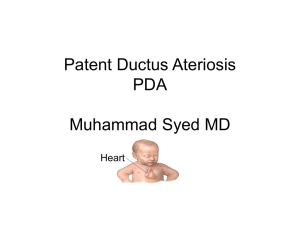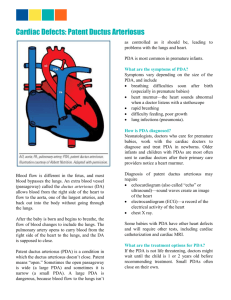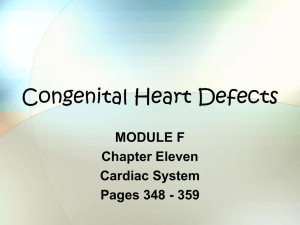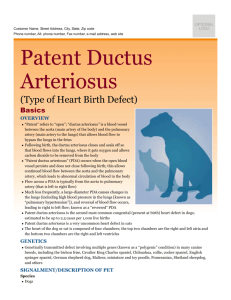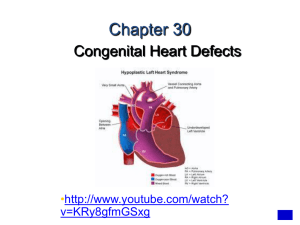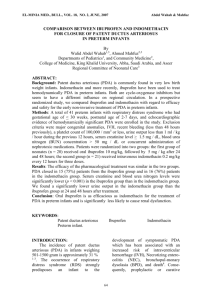powerpoint
advertisement
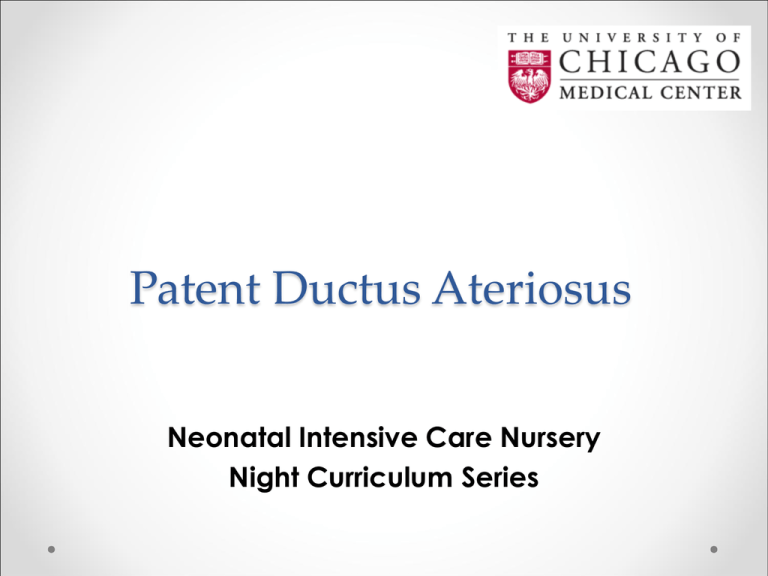
Patent Ductus Ateriosus Neonatal Intensive Care Nursery Night Curriculum Series Fetal Circulation During Fetal Life: 1. What is the resistance in the Pulmonary Vasculature? 2. What is the systemic vascular resistance? 3. Which direction does blood shunt through the Ductus Arteriosus? PDA: RL Shunting Pulmonary Vascular Resistance: HIGH Systemic Vascular Resistance: LOW What Major Changes in Infant Circulation occur following birth? • Lungs: o Lungs expand o PaO2↑’s Pulmonary vasodilatation o Drop in pulmonary vascular resistance. • Systemic Circulation: o Resistance ↑’s with placental removal • PDA: o flow reverses to L R shunting o Begins to functionally close due to ↑ PaO2, and decreased PGE2 levels Case • Called to the bedside of a 5 day old 25 week infant with worsening respiratory distress. He is requiring higher O2 settings and continues to have multiple desaturations despite increased ventilator settings What is in your initial differential for this infant’s respiratory distress? • Respiratory: o Respiratory Distress Syndrome (RDS) o Pneumothorax o Pulmonary Hemorrhage • Cardiac o Persistent Ductus Arteriosus (PDA) o Ductal Dependent Heart Lesion • ID o Sepsis o Pneumonia • GI o NEC • Neuro: o IVH o Seizures Physical Exam Vitals: 160, RR 68, BP 45/20, SaO2 85% Weight: 980 grams (up 80 grams from 1 day prior) HEENT: unremarkable Pulm: tachypneic, decreased lung sounds at bases, crackles heard bilaterally posterior lung fields • CV: 3/6 systolic murmur loudest at LUSB, bounding palmar pulses, active precordium, 2+femoral pulses, CR <2 seconds • Abdomen: soft, active bowel sounds • Skin: warm, dry • • • • What is the likely cause of this infants respiratory distress? A. B. C. D. Respiratory Distress Syndrome PDA Sepsis NEC What is the likely cause of this infants respiratory distress? A. Respiratory Distress Syndrome B. PDA C. Sepsis D. NEC What Physical Exam findings are consistent with PDA? Cardiac: Active Precordium, Widened Pulse Pressure, Bounding Pulses Murmur: systolic at LUSB/Left Infraclavicular, may progress to continuous (machinery) Respiratory Sx: Tachypnea, Apnea, CO2, increased vent settings What further diagnostic studies could be done to confirm this? • CXR • Echocardiogram What findings on this CXR are suggestive of a PDA? Increased Pulmonary vascular makings Uptodate.com Cardiomegaly Echocardiogram • Gold standard for diagnosing PDA Taken from Neo Reviews Which Infants are at greatest risk? • The Youngest: risk increases with decreasing gestational age • The Smallest: 80% of ELBW infants (BW <1000g) with a murmur progress to large persistent PDAs What are complications of having hemodynamically significant PDA? • • • • • • • • Pulmonary Edema Pulmonary Hemorrhage BPD NEC Heart Failure IVH Prolonged ventilator/O2 support Longer Duration of hospitalization. What makes a PDA Hemodynamically Significant? Pulmonary Overcirculation (↑ Qp) Oxygenation failure Increased Vent Requirements Pulmonary Edema Cardiomegaly Systemic Hypoperfusion (↓ Qs) Systemic Hypotension End-Organ Hypoperfusion Renal Insufficiency NEC IVH Acidosis (metabolic, lactic) What are three main options for treatment? 1. Conservative/Supportive Management 2. Pharmacotherapy 3. Surgery What Supportive Measures can you take in an infant with a symptomatic PDA? • Ventilator Strategies: o Adequate Oxygenation o Permissive Hypercapnea o Use of PEEP • Mild Fluid restriction: 110-130 ml/kg/day • Heme: Maintenance of HCT 35-40% Pharmacotherapy • What 2 agents are typically used? o Indomethacin o Ibuprofen Your Patient is on indocin • The team decides to treat your patient with indomethacin... • How does indomethacin help close a PDA? • MOA: Indomethacin o Cyclooxygenase inhibitor o COX enzyme necessary for generating PGE2 (potent vasodilator) • Adverse-Effects: o reduces cerebral, gastrointestinal, and renal blood flow o Decreased urine output o Platelet dysfunction • Would you continue/start feeds on this infant? o given concern for increased risk of NEC many neonatologists hold feeds during indomethacin therapy What are some contraindications to indomethacin? Proven/ suspected infection Active bleeding e.g. IVH, NEC Thrombocytopenia and/or coagulation defects Necrotizing enterocolitis Severe Renal Impairment Congenital heart disease with ductal dependent lesion Complications to watch for… • What are you going to instruct the RN to notify you about in this patient? o Decreased Urine Output • Indocin should be held if UOP < 1 ml/kg/h o Abdominal Changes o Signs/Sx of bleeding • Are there any labs you would like to check before/after starting indomethacin? o CBC: to check platelets o BMP: to check BUN and Creatinine After two trials of indocin your patient still has a symptomatic PDA what next steps might you take? • Continue supportive therapy through ventilator and fluid management • If infant continues to require high ventilator support and echo demonstrates a large PDA consider surgical ligation • Indications? Surgical Ligation o Persistent Symptomatic PDA after 1-2 trials of Indomethacin or Motrin o Contraindication to Indomethacin or Motrin • Complications? o o o o o o o o recurrent laryngeal nerve paralysis blood pressure fluctuations respiratory compromise infection intraventricular hemorrhage chylothorax BPD death Surgical Ligation • Long Term Outcomes o Current studies do not demonstrate that ligation decreases incidence of BPD o Some data to suggest infants that have surgical ligation are at greater risk for neurocognitive delays • Surgery should only be used for infants that have failed medical management and are symptomatic Objectives • • • • • • Clinical Findings and Symptoms Consistent with PDA Diagnosis of PDA Complications of PDA Indications for treatment Treatment Options Complications of Treatment References: • Chorne N, Leonard C, Piecuch R, Clyman RI. Patent ductus arteriosus and its treatment as risk factors for neonatal and neurodevelopmental morbidity. Pediatrics. 2007;119(6):1165. • Gien, J. Controversied in the Management of Patent Ductus Arteriosus. Neoreviews 2008: 9, 477-482 • Masalli, R. Optimal Fluid Management in Premature Infants with PDA. Neoreviews 2010; 11: 495-502 • Philips , Joseph B. Management of patent ductus arteriosus in premature infants. UptoDate (www.uptodate.com) • Phillips, J. Pathophysiology, clinical manifestations, and diagnosis of patent ductus arteriosus in premature infants. UptoDate (www.uptodate.com) • Nelson Text Book of Pediatrics
